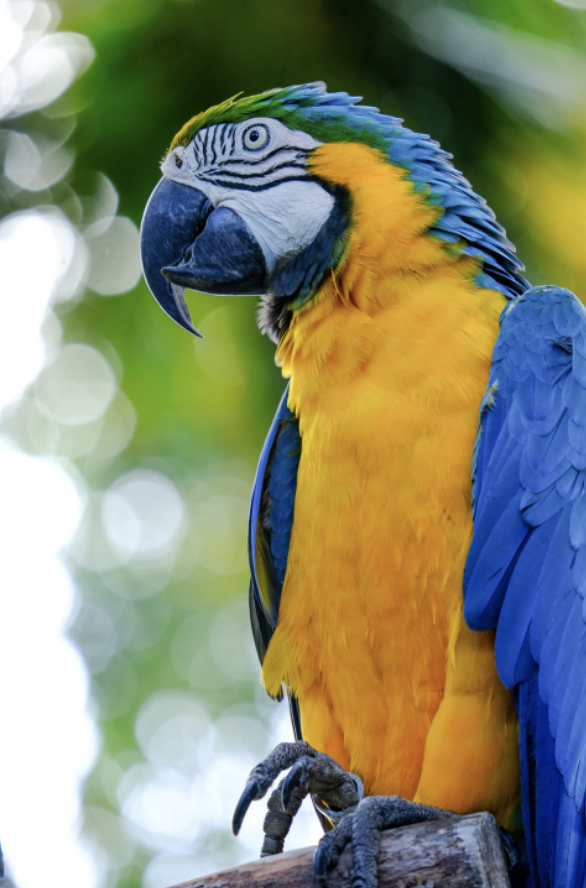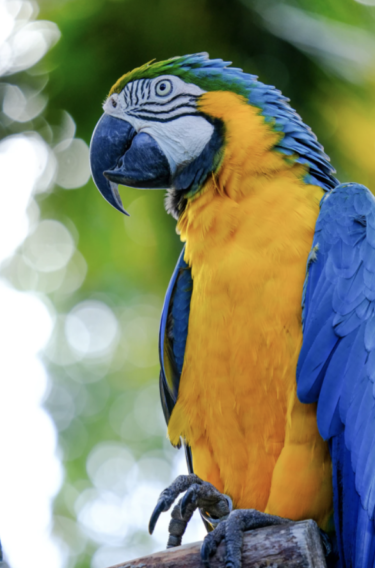はじめに
先週2月13日に受験したTOEFLの採点結果が展開された。リーディングではなんとか半分の15点だった。ライティングとスピーキングは、ともに半分に若干足らずに13点。問題はヒアリングでわずか5点。これはひどい。ヒアリングは問題外のレベルだったので、頑張ってヒアリングを続けている。やはり英語脳を鍛えるのが王道だろう。ライティングとスピーキングは全く準備せずだったので、次回は少なくとも6割以上の点数をもらえるように頑張ろう。今日のTED動画は「なぜオウムはヒトのように話すのか(Why parrots can talk like humans)だった。せっかくの機会なのでインコとオウムについても調べてみた。
オウムとインコの違い
parrotは通常オウムを意味する。一方、インコはparakeetと言う。そういえば、ABEMA TVの今日好き「冬休み編」に最近ハマっているけど、くうたが途中参加して、インコを飼っていると言っていた。インコとオウムはどう違うのか。これにはいくつかの特徴的な違いがある。インコはまず冠羽がなく、カラフルで中小型でおしゃべり上手。一方のオウムは種類が21種類と少なく、冠羽があり、大きめだという。確かに、オウムはインコに比べて大きなイメージがある。
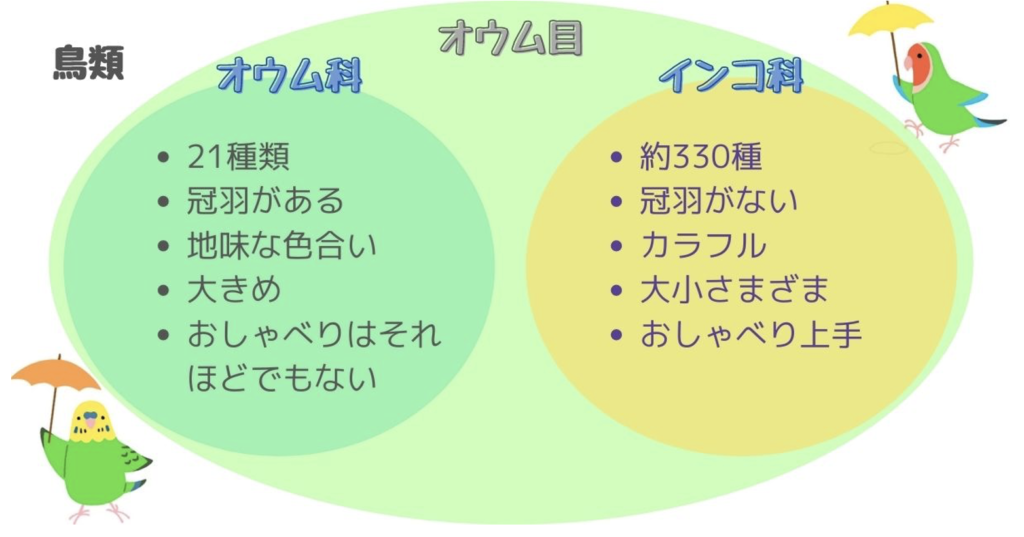
(出典:dia-jolly)
世界のインコ・オウムの分布
オウムよりインコの方が種類が多いため、世界の分布でもインコが目立つ。セキセイインコやオカメインコはオーストラリアだ。全般的に赤道直下の温暖もしくは熱帯系に多いようだ。
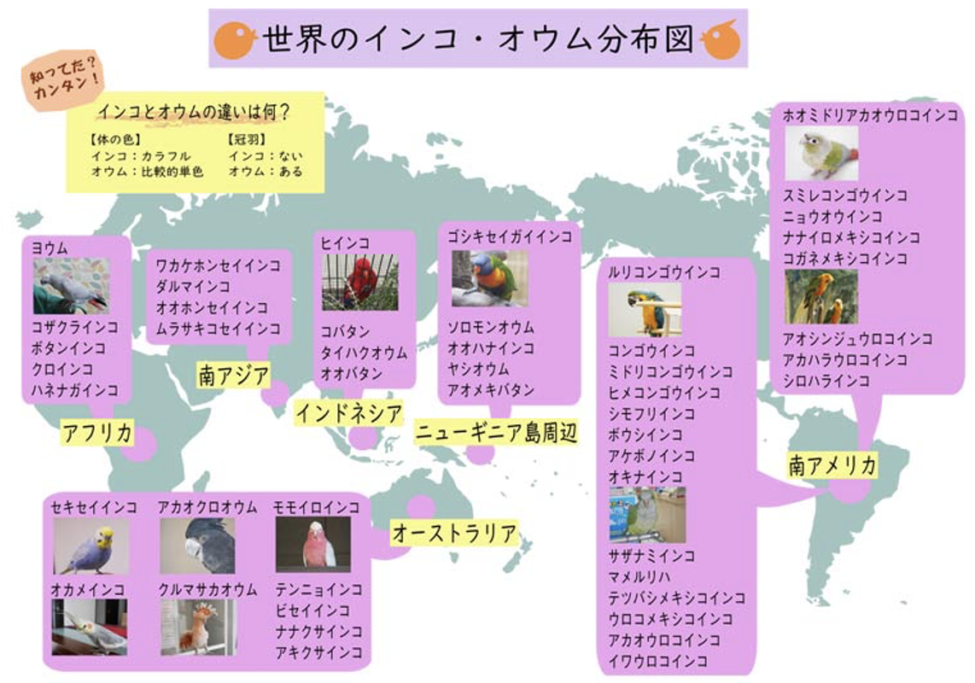
(出典:akahel)
TED-Edの動画
今回試聴したTED動画を下に示す。主題はオウムはなぜヒトのように話すのかというものだ。そんなこと考えたことがなかった。興味のある方はまず見てほしい。
(出典:Vox)
4つの質問
動画を試聴するとQ&Aがある。今回は4つの質問が用意されていた。
Q1) What is a bird’s voice box called?
ヒトには声帯があり、これを振動させて声を出す。猿は話せないと考えられていたが、最近の研究ではヒトと猿の喉の構造の差異は大きくなく、構造的には話せることを実証した。冒頭の映像でも猿の声をシミュレーションしている。猿が話せないのは喉の構造ではなく、脳の構造の違いによるようだ。なお、この質問の人の声帯に相当する器官は何かというと鳴菅(syrinx)が答えとなる。
Q2) What is the shape of the lower respiratory system in humans and birds?
動画の中で下気道(lower respiratory system)がどうなっているかという質問。オウムのシリンクスはY字型のパチンコを逆にしたように形と説明していた。設問はY字ではなくT字だけど、これかなあ。ちょっと自信がない。
Q3) How do humans and birds differ in how they produce sound?
これは記述式の問いで、「人間と鳥は音の出し方がどう違うのか?」という意味だ。人は声帯を振動させて発声するけど、鳥類はシリンクスと呼ぶ鳴管と肺の間を流れる空気の振動で音を出す。英語でいえば、次のような感じだろうか。
Q4) What is esophageal speech?
これも記述問題だ。なかなか難しい。設問は、「食道発声とは?」というシンプルな質問だ。オウムには唇がないけど、シリンクスを通じて肺との間の空気が流れる力を利用する。英語でいえば、次のような感じだろうか。
シリンクスの仕組み
オウムなど鳥類がもつ鳴管(syrinx)の仕組みを少し調べてみた。鳥の声やさえずりを生むのが鳴管だ。人は、口の形や舌の形を変えて音を作るけど、オウムは胸の鳴管やのど、筋肉が発達した舌をうまく変化させて音をつくる。オウムにとって鳴き声は仲間との大事な通信手段だ。ヒトも声で会話するけど、ヒトの声を真似るのはヒトと仲良くしたいという本能なのだろうか。インコも人が喜ぶと、いろいろな言葉を覚えようとしてくれる。その意味ではコミュニケーションペットだ。
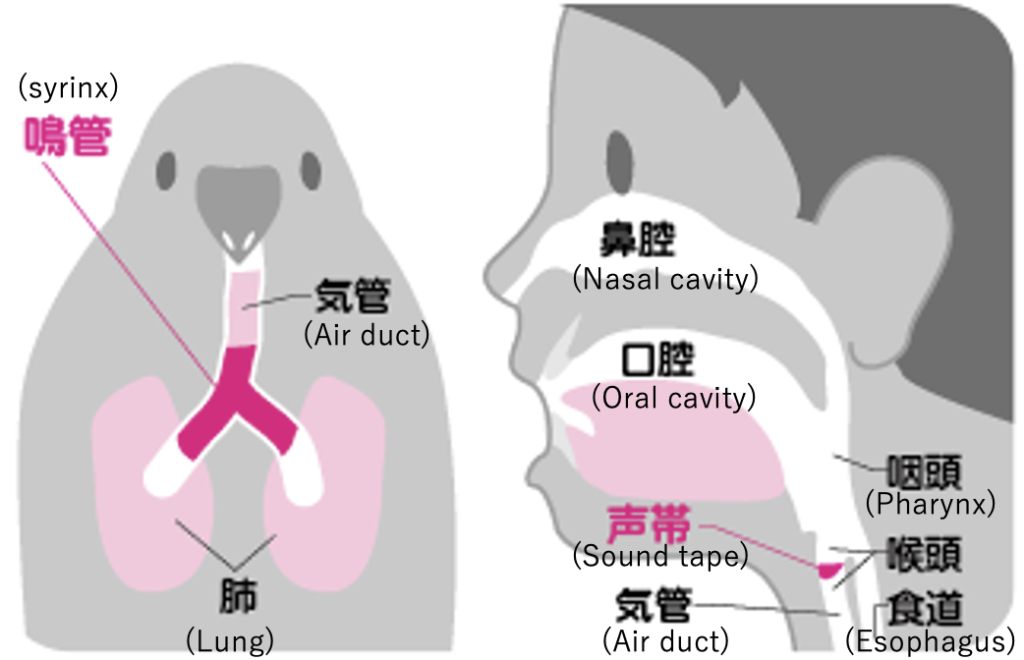
(出典:子供の科学)
カージナルス
米セントラルリーグのカージナルスのイメージカラーは赤だ。日本では、広島カープが赤ヘルだ。カージナルスは、本拠地のセントルイスがあるミズーリ州の鳥がショウジョウコウカンチョウなので、チーム名となった。チーム創設時に入手した生地の色がカージナルレッドだったという説もある。カージナルスは米国民に最も愛されている野鳥のひとつであり、アメリカ合衆国の北部などで見られている。
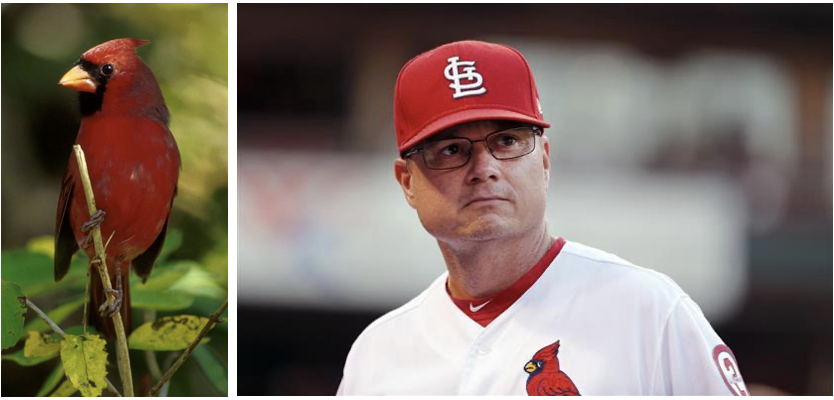
(出典:カージナルス)
絶滅の危機:カカポ
TOEFLだと、絶滅危惧種としてのkakapoなどもトピックになりそうだ。カカポはニュージーランドの平和な環境でのんびりと暮らしていたのに、1000年前にマオリ人が到着して狩りのターゲットとなり、また1840年代からヨーロッパ系白人が移住し始めると、彼らと共にやってきた猫、イタチ、クマネズミなどが天敵となった。1880年代にウサギを減らそうと白てん、フェレットなどのイタチ類がヨーロッパから移入され、kakapoを含む多くのニュージーランド固有種が絶滅の危機に追いやられた。
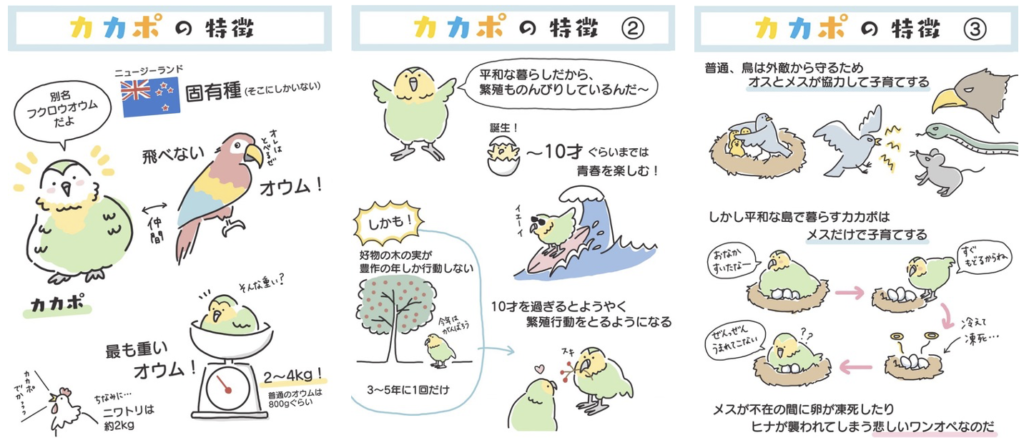
(出典:カカポ)
まとめ
今日の動画の主題は、ヒトは声帯の振動で音を出すけど、鳥は鳴管(syrinx)に流れる空気の動きで音を出す。ヒトはお腹から声を出すけど、鳥は肺=胸を使って音を出す。オウムやインコがヒトの真似をして話すのは可愛いし、驚くけど、ヒトと少しでも仲良くなりたいのだとしたら本当に愛しい存在だ。ヒトとヒトでもヒトと動物でもお互いの感情を言葉にして気持ちを通わせるということが大事なのだと思う。将来はロボットも心をもってヒトと言葉を交わすようになるのだろうか。
以上
最後まで読んで頂きありがとうございます。
拝
参考:英語スクリプト(いくつかの単語には日本語を追記)
Why parrots can talk like humans
This is what a macaque monkey would sound like if it suddenly proposed. Will you marry me? Yeah, I hate it too. Let us play it again: Now, of course, that is not a real monkey, it is a computer simulation that was part of a study on monkey vocal tracts. And what it shows is that monkeys have a strikingly similar vocal structure to humans. But despite all these similarities, they can not speak So here is a question. Compared to monkeys, birds are nothing like us.
Yet this bird is talking to me right now. How? Birds do not have lips. They do not have teeth, their “nose” is totally different from ours, but they do have something we do not. They actually have a different kind of voice box than we do. It is called a syrinx. This is Mya Thompson – She studies birds at Cornell University. They actually have two independent voice boxes. In birds, and in humans, the lower respiratory system is shaped sort of like an upside-down slingshot(パチンコ). The top part is the trachea or windpipe(気管), the bottom part is the lungs(肺), and these two pieces move air in and out.
In humans, the voice box is called the larynx(喉頭), and it is located above the trachea. It contains vocal “folds” that vibrate when air flows through to produce sound. And humans primarily shape that sound with their mouths. But in birds, the voice box is called the “syrinx”. And it is at the bottom of the trachea. Instead of just sending air through vocal folds like we do, birds actually control the muscles on the walls of the syrinx to shape and produce sound. Take a look at this is cardinal as it sings. You can actually see that the noise comes directly from the chest. The bird extends and shortens its neck and opens or closes its beak to refine the noise, but most of the control is actually happening in the syrinx. It is a powerful sound for such a small animal, but that is not even the most impressive part: Cardinals tend to make these “whoop” notes and they go by very very quickly. They are able to produce more pitches than a piano in less than a tenth of a second. They are actually switching from one side of the syrinx to another seamlessly to make this very very incredible span of pitches.
The syrinx also lets some birds replicate sounds with astonishing accuracy. For example, BBC Wildlife caught a lyrebird perfectly imitating a camera in the wild. And of course, some of them imitate us. Parrots are born communicators. From the start, their brains are wired for speech. So when they are first hatched they are learning right away and they are learning from everything around them. But speaking human is no easy feat. We have got our vowels A-E-I-O-U. Our plosives “Pocket”. And a variety of consonants – that we even sometimes struggle to enunciate clearly Rural? So to pull off such clarity in human speech, parrots really show off their ability to manipulate their vocal tract. Plosives, for example, require using our lips. To make up for the lack of lips, parrots use something called esophageal speech – it is almost like burping that comes from within the trachea. The force of air replicates the plosive.
As for vowels, where we use our lips, tongue, and jaw, researchers have found that parrots move their tongues forward and backward and adjust their break opening to alter the sound. It seems like they are the only birds that are actually using their tongue like humans do to shape the sound that is coming out. Parrots have a natural desire to communicate. In the wild, they form strong bonds with their flocks but in captivity, the parrot forms a social bond with you and they want to communicate with you and they have the vocal anatomy(発声解剖学) to start mimicking(真似) you. When parrots live with us, we are their flock and they are determined to sing our song. So in this video, I showed you some of the physiology that lets birds produce sounds. But I wanted a quick and easy way to show you some of the interesting background research on neurology(神経学) that allows some of them to speak. So I created a website with Wix, where I have compiled a bunch of extras, including research and related content that gets you animals. It is a super-easy way to make a website, so click on your own. Wix does not directly impact editorial but their support does make videos like this one possible, so go check them out.

